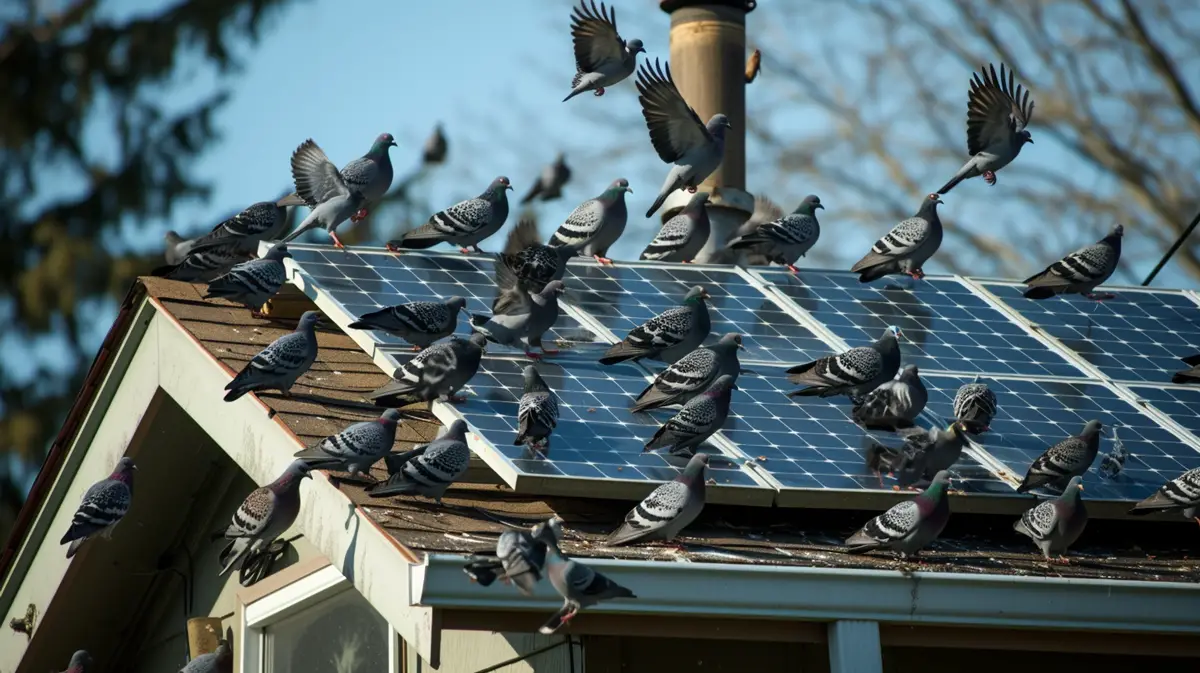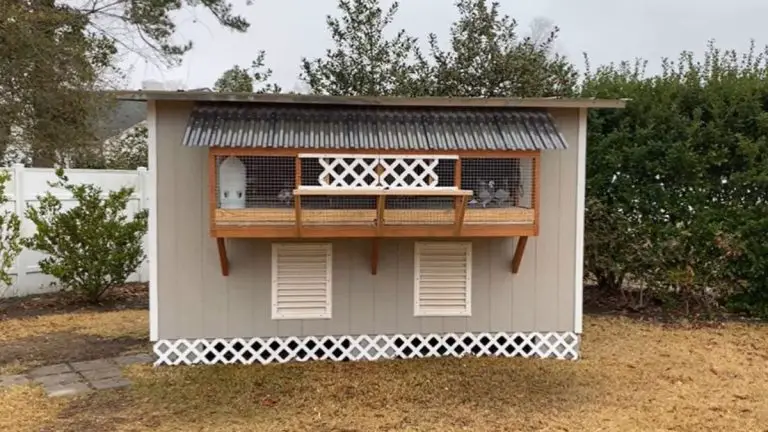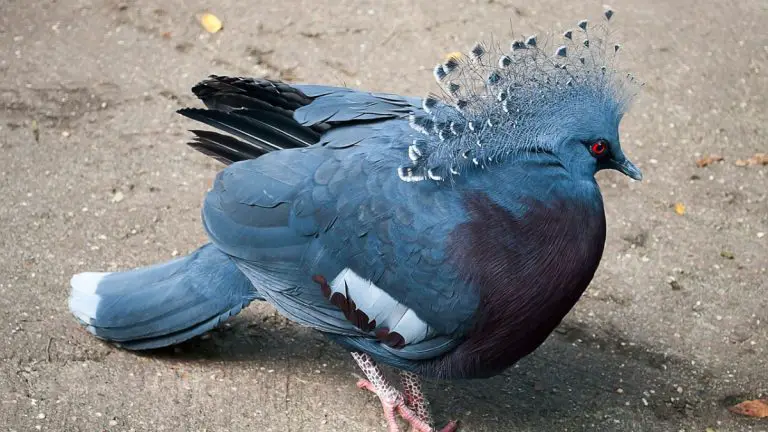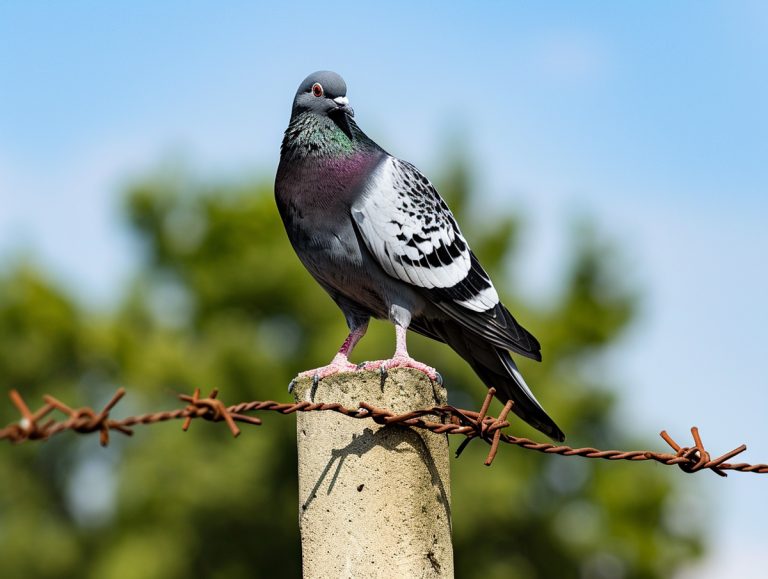Pigeon Proofing Solar Panels: Cost Breakdown
Are pesky pigeons wreaking havoc on your solar panels? If so, you’re not alone. Pigeons are notorious for perching and nesting on solar panels, causing damage and reducing their efficiency. But fear not! In this article, I’ll break down the cost of pigeon proofing your solar panels, so you can enjoy the benefits of clean energy without the hassle of bird-related problems.
Why do pigeons nest on solar panels?
Solar panels are an amazing source of clean and renewable energy. However, they can sometimes attract unwanted visitors – pigeons. You might wonder why these birds choose to nest on solar panels. Well, I’m here to shed some light on this interesting behavior.
One of the main reasons pigeons are drawn to solar panels is because they provide a safe and elevated place for nesting. Pigeons naturally seek out secure locations as nesting sites to protect their eggs and young from predators. The raised surface of solar panels offers an ideal spot, as it provides shelter and protection from the elements.
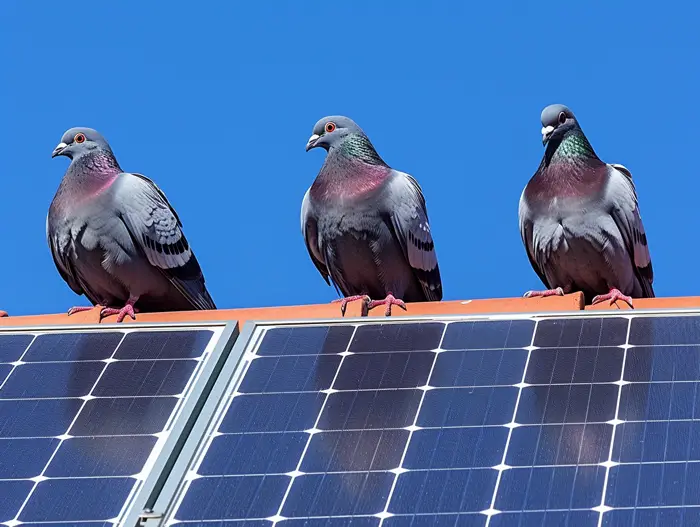
In addition to safety, pigeons are also attracted to solar panels due to the warmth they emit. As solar panels absorb sunlight and convert it into electricity, they generate heat. This warmth can be particularly appealing to pigeons, especially during colder seasons. It helps them regulate their body temperature and provides a cozy environment for nesting.
Another factor that contributes to pigeon nesting on solar panels is accessibility. Solar panels are typically installed on rooftops, which are easily accessible for pigeons. Their flight capabilities, combined with their ability to navigate urban environments, make rooftops an attractive option for nesting.
Now that we understand why pigeons are drawn to solar panels, it’s important to address the issue of their presence. While pigeons nesting on solar panels might seem harmless, they can actually cause significant damage. Their droppings can accumulate and corrode the surface of the panels, leading to a reduction in their efficiency.
So, how can we prevent pigeons from nesting on solar panels and protect our clean energy investment? Well, stay tuned for the next section, where I’ll delve into the cost of pigeon proofing solar panels. Remember, it’s crucial to find effective and humane solutions to ensure the longevity and efficiency of your solar panels.
The impact of pigeon nesting on solar panel efficiency
As an expert in the field, I have seen firsthand the effects of pigeon nesting on solar panel efficiency. Pigeons, with their ability to adapt to urban environments, are often drawn to the elevated and secure space that solar panels provide for nesting. However, while they may find it to be a convenient location, their presence can have a negative impact on the performance of solar panels.
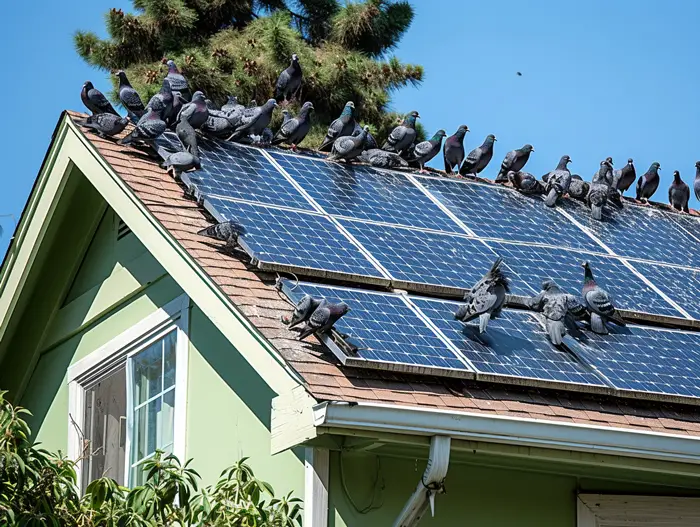
Here are some key points to consider regarding the impact of pigeon nesting on solar panel efficiency:
- Shading: Pigeon droppings can accumulate on the surface of solar panels, leading to shading and a reduction in the amount of sunlight that can be absorbed. This shading can significantly decrease the panel’s energy output.
- Blocked air circulation: Pigeon nests can obstruct the flow of air beneath the solar panels, impeding the cooling process. This can result in increased temperatures, leading to a decrease in the efficiency and lifespan of the panels.
- Corrosion: Pigeon droppings are highly acidic and can corrode the protective coatings on the modules. Over time, this corrosion can damage the surface of the panels, affecting their performance and durability.
- Maintenance costs: The presence of pigeons and their nesting materials requires regular cleaning and maintenance of the solar panels. This adds to the overall costs associated with their upkeep, making pigeon-proofing a worthwhile investment.
- Aesthetics: Pigeon droppings not only detract from the visual appeal of solar panels but can also be unsightly for surrounding areas. This can be a concern, especially for homeowners or commercial properties that want to maintain a clean and professional image.
Methods of pigeon proofing solar panels
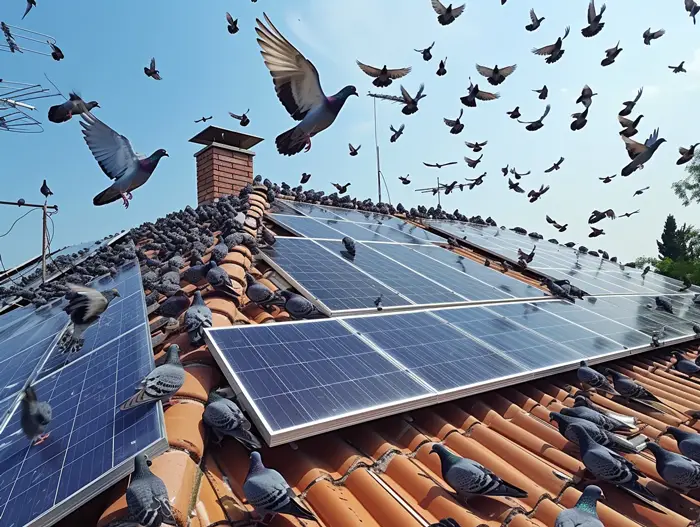
When it comes to protecting solar panels from pigeons, there are several effective methods available. These methods aim to create a barrier between the panels and the birds, preventing them from nesting and causing damage. Here are a few commonly used pigeon-proofing techniques:
- Mesh or Netting: One popular method is to use wire mesh or netting to cover the area beneath the solar panels. This creates a physical barrier that prevents pigeons from accessing the space beneath the panels. The mesh or netting should be properly secured to ensure its effectiveness.
- Spikes or Wires: Another option is to install spiked wires along the edges of the solar panels. The protruding spikes make it uncomfortable for pigeons to land on the panels, discouraging them from nesting. It’s important to ensure that the spikes are installed safely and do not cause harm to the birds.
- Slippery Surfaces: Some pigeon-proofing solutions involve applying a non-stick coating or slippery material on the surface of the solar panels. This makes it difficult for pigeons to land and grip onto the panels, discouraging them from nesting. It’s crucial to choose a coating that is environmentally friendly and does not affect the efficiency of the panels.
- Ultrasonic Devices: Ultrasonic devices emit high-frequency sounds that are bothersome to pigeons but are inaudible to humans. These devices can be installed near the solar panels to deter pigeons from approaching and nesting. It’s important to note that the effectiveness of ultrasonic devices may vary depending on environmental factors.
- Visual Deterrents: Visual deterrents, such as reflective surfaces or predator decoys, can be effective in discouraging pigeons from nesting on solar panels. These visual cues create an illusion of danger or a hostile environment, making the area unattractive to pigeons. Regularly changing the placement of visual deterrents can help maintain their effectiveness.
Remember, it’s essential to consult with a professional when choosing a pigeon-proofing method for your solar panels. They can assess your specific situation and recommend the best approach to protect your solar panels from pigeon nesting.
By employing these methods, you can effectively pigeon-proof your solar panels and ensure their longevity and optimal performance.
Cost of professional pigeon proofing services
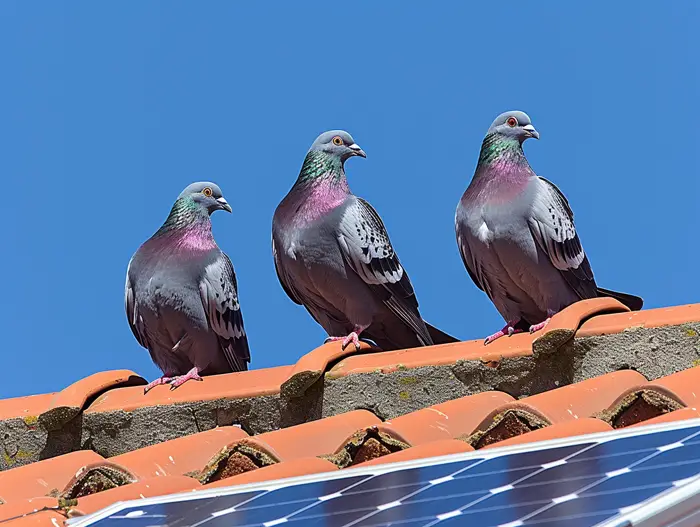
When it comes to protecting your solar panels from pigeons, it’s essential to consider the cost of professional pigeon proofing services. While some do-it-yourself methods can be effective, hiring a professional can provide you with long-lasting and efficient solutions. Here’s an overview of the costs involved in professional pigeon proofing services:
- Assessment and Consultation: Before any work is done, a professional pigeon proofing service will conduct a thorough assessment of your solar panels and the extent of the pigeon problem. They will then provide you with a detailed consultation on the best course of action. This initial assessment and consultation typically range from $100 to $200.
- Physical Barriers: One common method used by professionals is the installation of wire mesh or netting to create a physical barrier around the solar panels. This deters pigeons from nesting and causing damage. The cost of installing wire mesh or netting varies depending on the size of the solar panel array and the complexity of the installation. Generally, you can expect to pay $300 to $500 for this service.
- Spike Installation: Professionals may also recommend installing spiked wires to make it uncomfortable for pigeons to land on the solar panels. These spikes deter the birds from perching or nesting on your panels. The cost of spike installation depends on the size of the solar panel array and the number of spikes required. On average, the cost falls between $200 to $400.
- Coating Application: Another method employed by professionals is the application of non-stick coatings or slippery materials on the surface of the solar panels. These coatings make it difficult for pigeons to land and nest. The cost of coating application usually ranges from $200 to $400.
- Additional Deterrents: In some cases, professionals may recommend additional deterrents such as ultrasonic devices that emit bothersome sounds or visual deterrents like reflective surfaces or predator decoys. The cost of these additional deterrents can vary depending on the specific products used and the size of the solar panel array. Generally, you can expect to spend $100 to $300 for these options.
It’s important to note that these cost estimates are just rough averages. The actual cost of professional pigeon proofing services will depend on factors such as the size of the solar panel array, the complexity of the installation, and the specific services and products chosen.
DIY pigeon proofing methods and their costs
When it comes to protecting your solar panels from pigeons, some people prefer to take matters into their own hands. DIY pigeon proofing methods can be an effective and budget-friendly option. Here are a few methods you can try, along with an estimated cost for each:
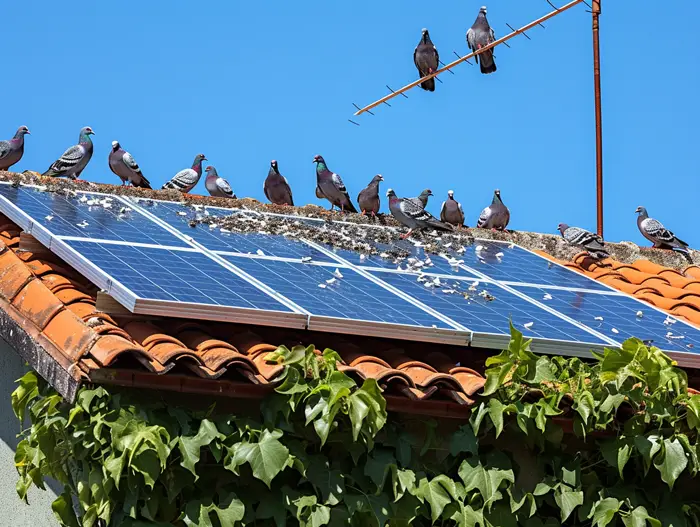
1. Wire Mesh or Netting
One popular DIY method for keeping pigeons away from solar panels is installing wire mesh or netting. This creates a physical barrier that prevents birds from accessing the area beneath the panels. The cost of wire mesh or netting can vary depending on the size of your solar panel array and the amount needed. On average, it can cost between $50 to $150, including the necessary tools and materials.
2. Spikes
Another common DIY approach is installing spikes on the edges of the solar panels. These spikes act as a deterrent, making it uncomfortable for pigeons to land and roost. The cost of pigeon spikes can range from $10 to $30 per linear foot. However, it’s important to note that spikes may not be suitable for all types of solar panel installations, so further research and consideration are necessary.
3. Coating Application
Applying a special coating to the surface of your solar panels can also help prevent pigeons from roosting. These coatings create a slippery surface that makes it difficult for birds to grip onto. The cost of a coating application will depend on the size of your solar panel array and the specific product chosen. On average, it can cost between $100 to $300, including the cost of the coating material.
4. Ultrasonic Devices and Visual Deterrents
In addition to physical barriers, there are also electronic devices and visual deterrents available as DIY options. Ultrasonic devices emit high-frequency sounds that are unpleasant to birds, while visual deterrents use reflective materials or predator silhouettes to scare them away. The cost of these devices can vary significantly, ranging from $20 to $100 or more, depending on the brand and effectiveness.
Conclusion
Pigeon proofing solar panels is a crucial step in maintaining the efficiency and longevity of your solar system. In this article, I have discussed several effective DIY methods for keeping pigeons away from your solar panels and provided estimated costs for each method.
Installing wire mesh or netting is a popular and cost-effective option, offering reliable protection against pigeons. Spikes are another effective method, especially for flat solar panels. Applying a special coating can be a more expensive solution, but it offers long-term protection and is aesthetically pleasing.
For those who prefer non-physical deterrents, ultrasonic devices and visual deterrents can be effective, though their success may vary depending on the bird population in your area.
Remember, when choosing the right pigeon proofing method, it’s essential to consider the specific requirements of your solar panel installation. Factors such as panel type, location, and access should be taken into account.
By investing in pigeon proofing measures, you can ensure that your solar panels remain free from damage and continue to generate clean energy for years to come.
